Planning policy - section 3F: research
Report commissioned to help develop a Scotland wide Section 3F planning policy, by proposing reasonable levels of CO2 (Carbon dioxide) emissions reduction that can be expected from use of low and zero carbon generating technologies (LZCGTs) in new buildings.
Appendix E: Supporting Statistical Data
Statistical Data Relating to new Dwellings in Scotland
The data detailed within Appendix E relates to a study carried out in 2015, which looked at Section 3F Policy and the deployment of Low and Zero Carbon Generating Technologies (LZCGT) in Scotland (Onyango et al., 2016; Burford et al., 2019). The dwellings within this study were randomly selected from five planning authority areas which were early adopters of Section 3F policy. These planning authorities represented regions ranging from remote rural to major urban centres. The designs for all the 402 new dwellings within the data set were submitted to planning between 2012 and 2014, and were either completed or under construction at the time of the study. The data represented here was all extracted from SAP documents submitted to and approved by building standards. All dwellings met the 30% reduction in CO2 emissions (relative to the 2007 standard) legislated for in Scottish Building Standard 6.1 at the time of the study.
Although consisting of a limited number of new dwellings built to less onerous requirements than the current Scottish Building Standards; it was felt that if these limitations were borne in mind, the data was contemporary and comprehensive enough to give a fair representation of the distribution of size, occupancy, and energy demands in new dwellings in Scotland. The data was therefore utilized as an aid to determining and confirming the rationality of some of the assumptions made in the development of Proposal 1 and Proposal 2.
Defining a Modestly-sized Dwelling
A key parameter for both Proposal 1 and Proposal 2 was that although the targets should be ambitious, they also needed to be readily achievable. In particular they should not be overly onerous or impact negatively on the ability to deliver essential domestic infrastructure such as affordable housing in a cost-effective way. For Proposal 1, protecting this sub-group of modestly-sized dwellings was used as the critical limiting context in determining what would be a reasonable minimum LZCGT contribution to annual energy demand that could be sought by the existing Section 3F policy.
Recognising the need to reduce energy demand as the essential first step to achieving CO2 emission reduction, Proposal 2 took a different tack than current Section 3F policy (Urge-Vorsatz et al., 2013; Beradi, 2016; Grove-Smith et al., 2018). The aforementioned LZCGT study had clearly revealed that the majority of large new dwellings had proportionally larger annual energy demands per capita (AED/Capita) than more modest dwellings. This is primarily a result of large heated living spaces and low average occupancy rates (Figure E.7, E.8, E.9; BRE, 2008; Burford et al., 2019). Proposal 2 therefore sought to limit annual energy demand in new dwellings to an acceptable level, and defined that level relative to a modest-sized energy-efficient dwelling.
Both proposals therefore needed to define what would be considered a modestly-sized dwelling.
The data collected during the 2015 study represents 402 new dwellings ranging in size from 48.7m2 to 480.9 m2 (Figures E.1 – E.10). The average total floor area was calculated at 125.3 m2 for the complete data set. This was surprisingly large. In Scotland the average size of a dwelling built post 1982 is 101m2. However whilst the average urban dwelling is just 93m2, the average rural dwelling is 47% larger at 137m2. Further the average detached house is 139m2, whilst the average flat is just 58m2 (Scottish Government, 2017b, pp. 18-19). The larger than average floor area of the sample might therefore have several simple explanations. Only one of the five local authority areas studied could be considered a major urban centre, whilst two could be considered fairly remote rural areas. The sample therefore might have a higher percentage of larger rural dwellings. It may also be representative of the fact that during this period the construction sector was still recovering from the financial crisis and there were very few large scale developer housing projects being undertaken. These typically contain more modest sized housing. As a result the distribution of dwelling sizes within the study might be slightly skewed towards larger architect designed one-off housing than would have normally been expected.
The lower limit of this critical size range was therefore simply defined as 45m2. However two figures were considered for the upper limit, 100m2 and 130m2. The statistical data for each is summarised in Table E.1, along with data for the complete data set. On consideration of these factors and the recognition that the occupancy rate of dwellings appears to alter at around 90m2 and saturates at about 3 occupants soon thereafter, it was decided that the upper limit would be set at 100m2 (BRE, 2008).
A modestly-sized dwelling was therefore defined for both Proposal 1 and Proposal 2 as between 45m2 and 100m2. This critical sized range represented 56% of all dwellings in the data set, and provided accommodation for 50% of all occupants (Table E.1).
Defining Levels of Fabric Energy Efficiency for Modelling
The methodology used to determine target levels in both Proposal 1 and 2 were based on modelling the expected annual energy demand of dwellings in past, present and future contexts. This necessitated making assumptions about the level of fabric energy efficiency that was likely to be encountered in these scenarios.
The data from this previous study is a real world representation of the level of fabric energy efficiency that could be expected and was readily achievable under the earlier 30% CO2 emission reduction standard. The average annual space heat demand per m2 for the entire data set was calculated at 46.3kWh/m2.annum, with actual values ranging from 13.7kWh/m2.annum to 93.4kWh/m2.annum. For dwellings within the critical size range of 45m2 to 100m2 this average value was slightly lower at 41.6kWh/m2.annum (Table E.1). This was probably partly because smaller dwellings tend to have simpler, more compact designs and more efficient form factors (Cotterell and Dadeby, 2013). Figure E.6 shows the distribution of annual space heat demand per m2 (SHD/m2) for the entire data set. The peak is clearly within the 40 to 45kWh/m2.annum range, with 66.9% of new dwellings achieving an annual SHD/m2 of less than or equal to 45kWh/m2.annum. This fabric energy efficiency was therefore determined as suitable for modelling past energy demand scenarios (Appendix B: Scenario 1).
Since this study was completed, the CO2 emission reduction required by Standard 6.1 has increased to 45% for new domestic buildings. We should therefore expect a corresponding increase in fabric energy efficiency and the use of LZCGT. Further the Committee on Climate Change (2019d) recommends that all new homes in the UK should be designed to deliver ultra-high levels of energy efficiency as soon as possible, and by 2025 at the latest. This was considered consistent with an annual space heat demand of 15 to 20kWh/m2.annum. Also Currie and Brown (2019) suggest that a rapid shift to a very high fabric energy efficiency standard comparable to Passivhaus (15kWh/m2.annum), MVHR and heat pump technology will be more cost-effective by the mid-2020s than taking a slower stepped approach to increasing fabric energy efficiency.
It was therefore determined to simply split the difference and use a space heat demand of 30kWh/m2.annum for present/near future energy demand modelling (Appendix B: Scenario 2). It was felt this would accurately represent a naturally ventilated highly energy efficient dwelling built to current standards. For future contexts post 2025 a space heat demand of 15kWh/m2.annum was selected (Appendix B: Scenario 3). This would represent an ultra-high energy efficient dwelling with mechanical ventilation heat recovery (MVHR).
Although the percentages are small, several dwellings within the 2015 data set achieved these values (Table E.1). There was only one Passivhaus in the data set and this was the only dwelling to meet the higher fabric energy efficiency target, although several others were fairly close. It had a floor area of 255m2, and an annual space heat demand of 13.7kWh/m2.annum (Appendix C: Worked Example 1). Ironically the dwelling with the highest space heat demand of 93.4kWh/m2.annum was a similar size at 266m2.
Determining whether the Acceptable Annual Energy Demand per Capita calculated for 2021 and 2024 are reasonable and achievable
Figures E.7, E.8, E.9 and E.10 analyse the data set in relation to predicted occupancy (BRE, 2008). Figure E.9 depicts the average annual energy demand per capita (AED/Capita) relative to dwelling size. The histogram sub-divides the data set into 10m2 groupings and calculates the average AED/Capita relative to these. This gives a reasonable indication of the changes in AED/Capita that are observed as the size of dwellings increase. The cumulative average traces the average AED/Capita for all dwellings up to and including that size grouping. The average AED/Capita for dwellings up to 100m2 was calculated as 2,369kWh/annum; this average encompasses individual AED/Capita ranging from 1,646kWh/annum to 3,514kWh/annum. For the entire data set the average AED/Capita was calculated as 3,258kWh/annum. The largest individual value recorded was for a 312m2 house which had an AED/Capita of 9,372kWh/annum (Table E.1).
Figure E.10 depicts the general distribution of AED/Capita values observed in the data set. There is a clear peak with 34.3% of dwellings recording AED/Capita between 2,200 and 2,600kWh/annum. In total 50.5% of the dwellings recorded an AED/Capita of less than or equal to 2,600kWh/annum.
When considering these figures it should be remembered that the CO2 emission reduction standard has increased since these dwellings were designed and built, and it can be expected that higher fabric energy efficiency standards will have been adopted and the use of LZCGT will have increased. Also it is not the intention of Proposal 2 that dwellings should meet the acceptable annual energy demand/capita (AAED/Capita) target purely by dint of increased fabric energy efficiency. It is accepted in the compliance methodology that some of the annual energy demand will be offset through the use of zero-carbon energy sources.
On reflection, the 2021 AAED/Capita target, for the present or near future, calculated as 1,910kWh/annum seems reasonable. Sixteen dwellings within the 2015 data set achieved this level without taking into consideration the use of zero-carbon energy to offset annual energy demand. All these dwellings were below 100m2 in area and some did utilize MVHR (which is embedded in the annual energy demand figure). It is presumed that a larger proportion of dwellings would achieve this level once other zero-carbon energy offsetting was taken into account.
The proposed 2024 AAED/Capita of 1,500kWh/annum is more challenging, especially for larger dwellings. None of the dwellings in the data-set achieved this level without zero-carbon energy offsetting. Two dwellings came fairly close with an AED/Capita of 1,646 and 1,652kWh/annum respectively. These were both 66.4m2 mid-terrace flats, with inherently good form factors, high levels of fabric energy efficiency and an MVHR system (Appendix C: Worked Example 2). However other dwellings were shown to be able to achieve this target through zero-carbon energy offsetting, including the Passivhaus example mentioned previously (Appendix C: Worked Example 1). The value calculated, though ambitious, therefore appears to be reasonable and achievable given the ambitions to build all new homes with ultra-high levels of fabric energy efficiency by 2025 at the latest (CCC, 2019b, p66; 2019d, pp 14-15).
| Area ≤ 100m2 | Area ≤ 130m2 | All Dwellings | Range: All Dwellings | Figures | |
|---|---|---|---|---|---|
| General Distribution: | |||||
| Percentage of total dwellings | 56% | 66% | 100% | Figure E.1 | |
| Percentage of total area of built accommodation | 34% | 43% | 100% | Figure E.2 | |
| Percentage of total number of occupants | 50% | 61% | 100% | Figure E.3 | |
| Percentage of total space heat demand | 31% | 40% | 100% | Figure E.4 | |
| Percentage of total annual energy demand | 36% | 46% | 100% | Figure E.5 | |
| Fabric Energy Efficiency: | |||||
| Average Space Heat Demand/m2 (kWh/m2.annum) | 41.6 | 42.9 | 46.3 | 13.7 - 93.4 kWh/m2.annum | |
| Dwellings with a SHD/m2 ≤ 45 kWh/m2.annum | 72.4% | 70.7% | 66.9% | ||
| (163 Dwellings) | (188 Dwellings) | (269 Dwellings) | |||
| Dwellings with a SHD/m2 ≤ 30 kWh/m2.annum | 7.1% | 6% | 4.9% | ||
| (16 Dwellings) | (16 Dwellings) | (20 Dwellings) | |||
| Dwellings with a SHD/m2 ≤ 15 kWh/m2.annum | 0% | 0% | 0.25% | ||
| (0 Dwellings) | (0 Dwellings) | (1 Dwelling) | |||
| Per Capita Analysis: | |||||
| Average Heated Living Space/Capita (m2) | 33 | 34 | 48 | 29.5 - 142.7 m2 | Figure E.7 |
| Average Space Heat Demand/Capita (kWh/annum) | 1,356 | 1,460 | 2,218 | 573 - 8,106 kWh/annum | Figure E.8 |
| Average Annual Energy Demand/Capita (kWh/annum) | 2,369 | 2,471 | 3,258 | 1,646 - 9,372 kWh/annum | Figure E.9 |
| Dwellings with a AED/Capita ≤ 1910 kWh/annum | 7.1% | 6% | 4% | ||
| (16 Dwellings) | (16 Dwellings) | (16 Dwellings) | |||
| Dwellings with a AED/Capita ≤ 1500 kWh/annum | 0% | 0% | 0% | ||
| (0 Dwellings) | (0 Dwellings) | (0 Dwellings) |
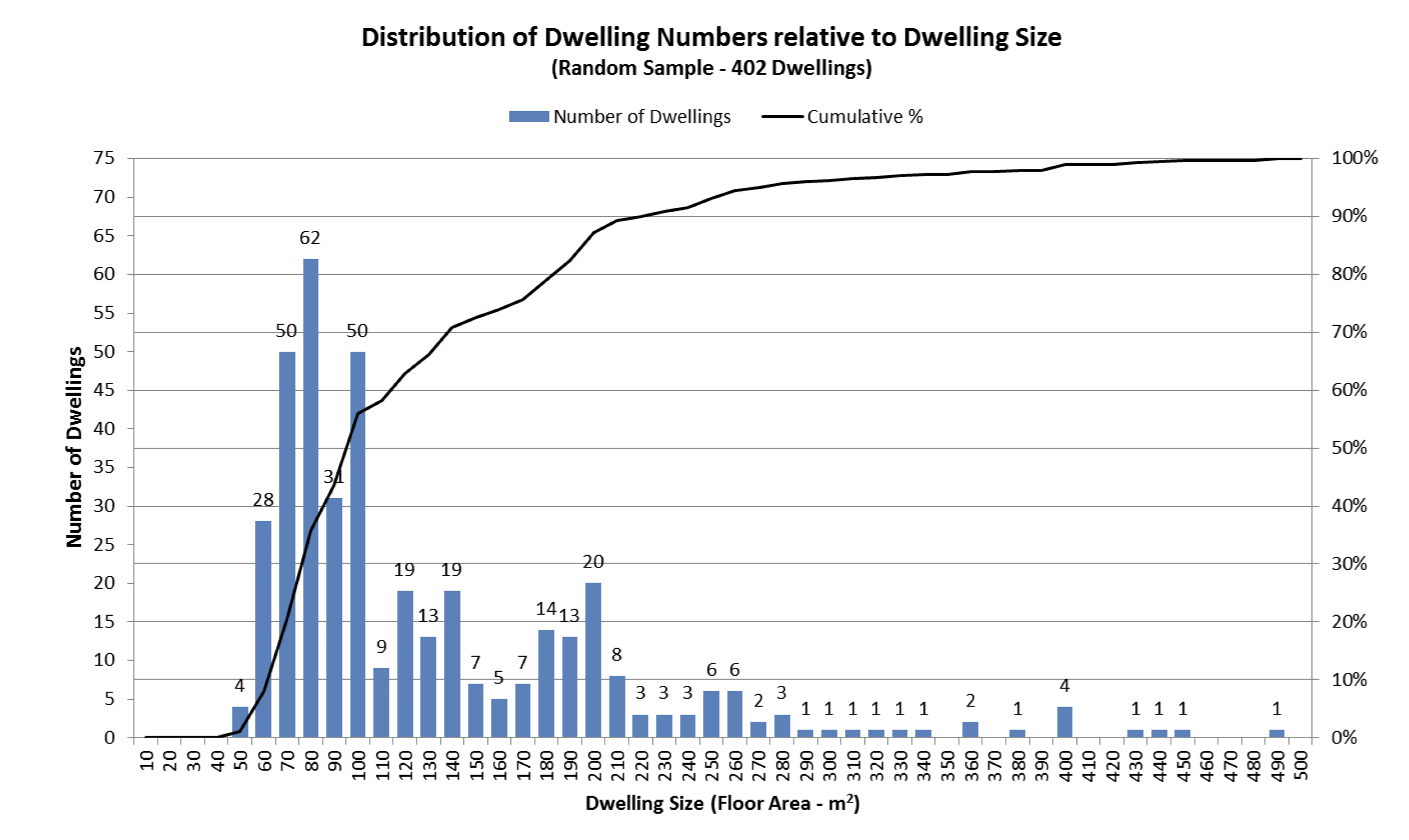
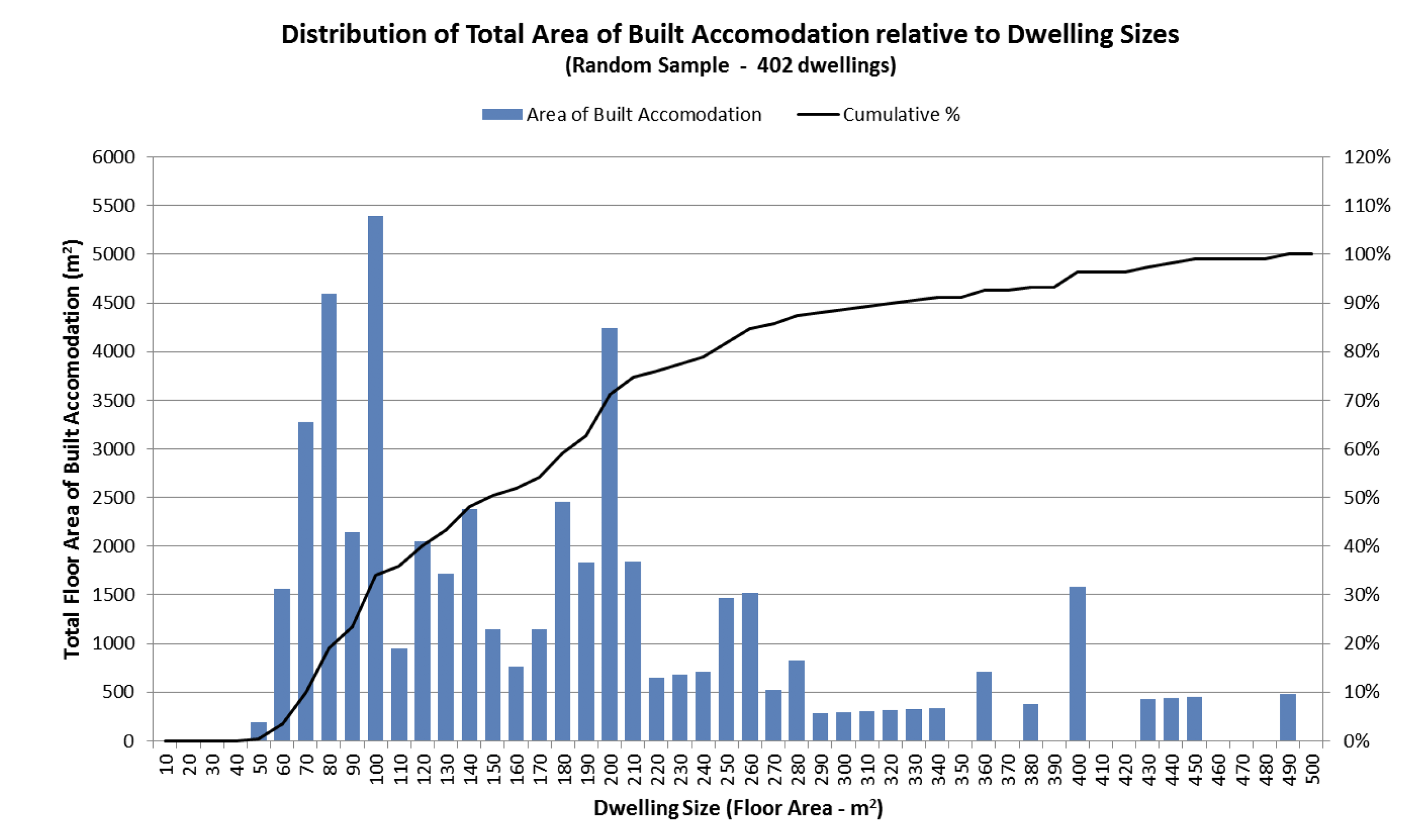
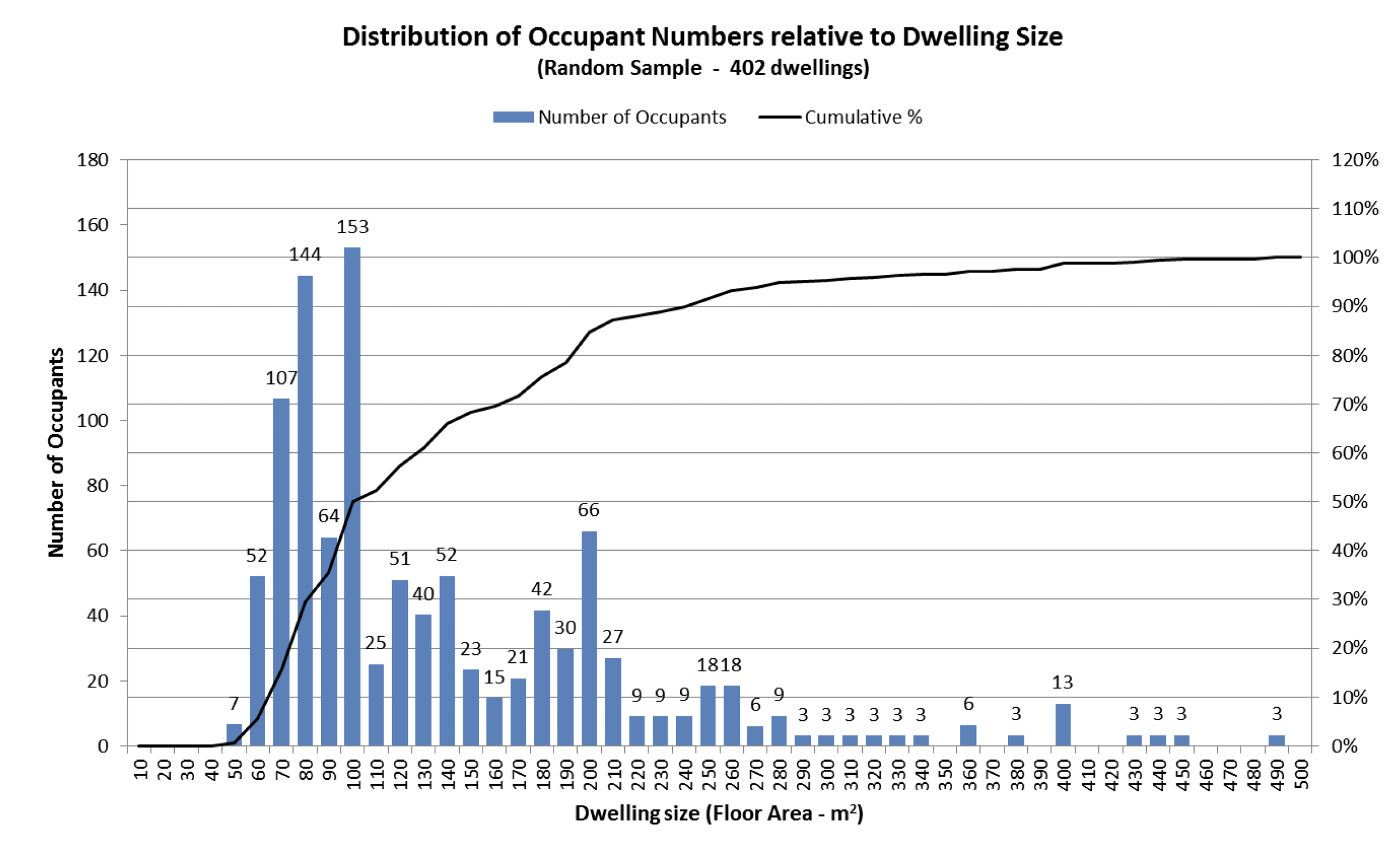
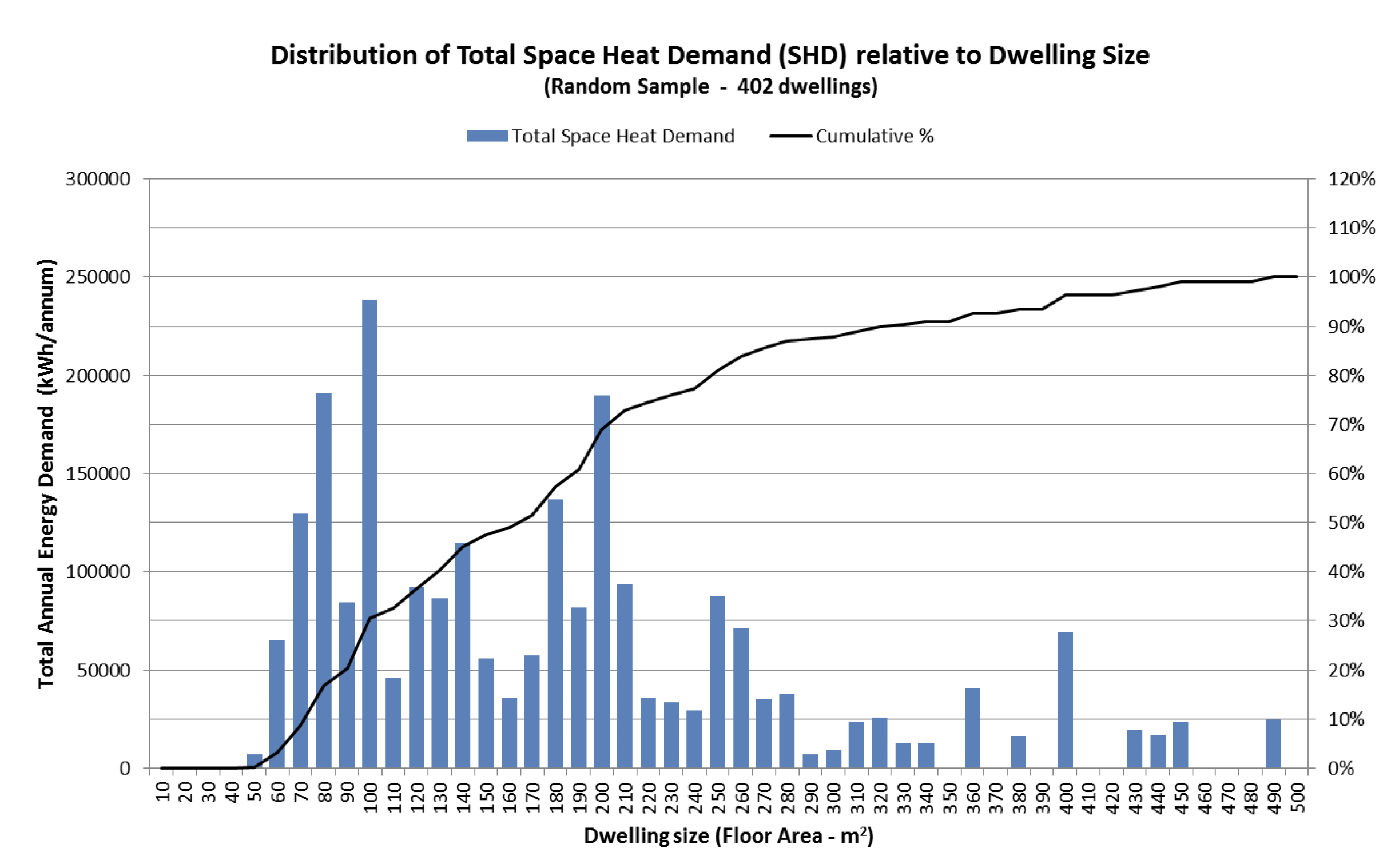
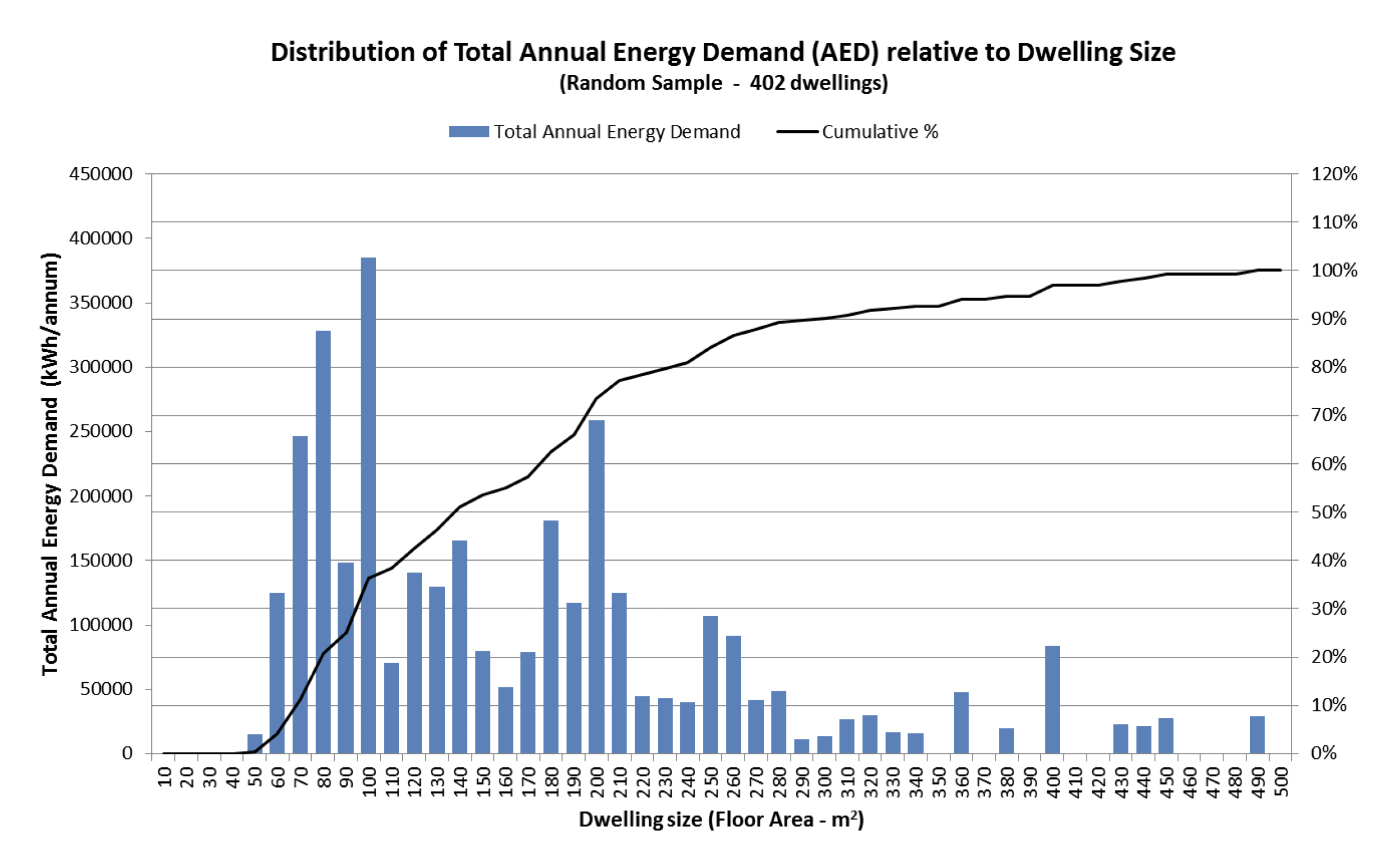
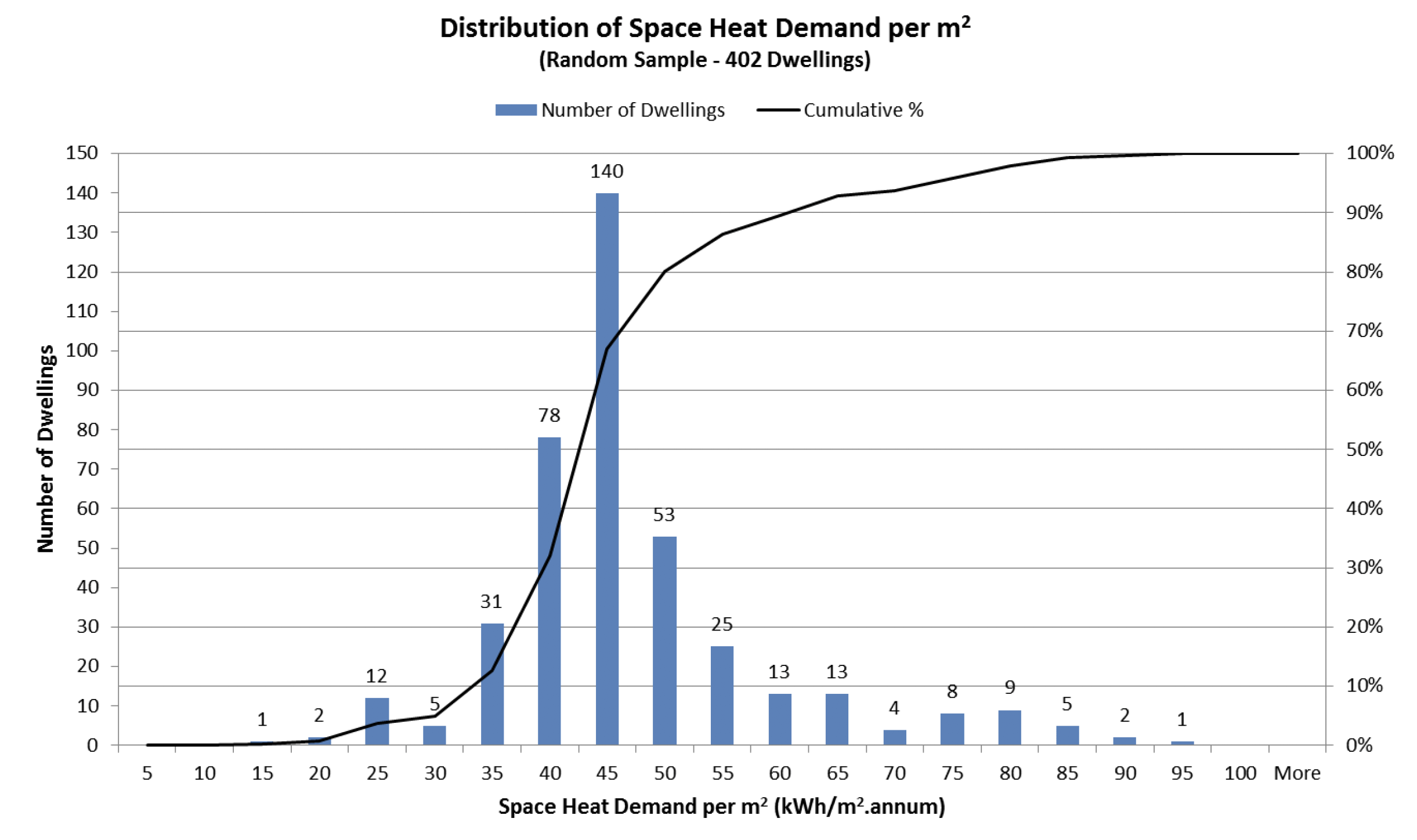
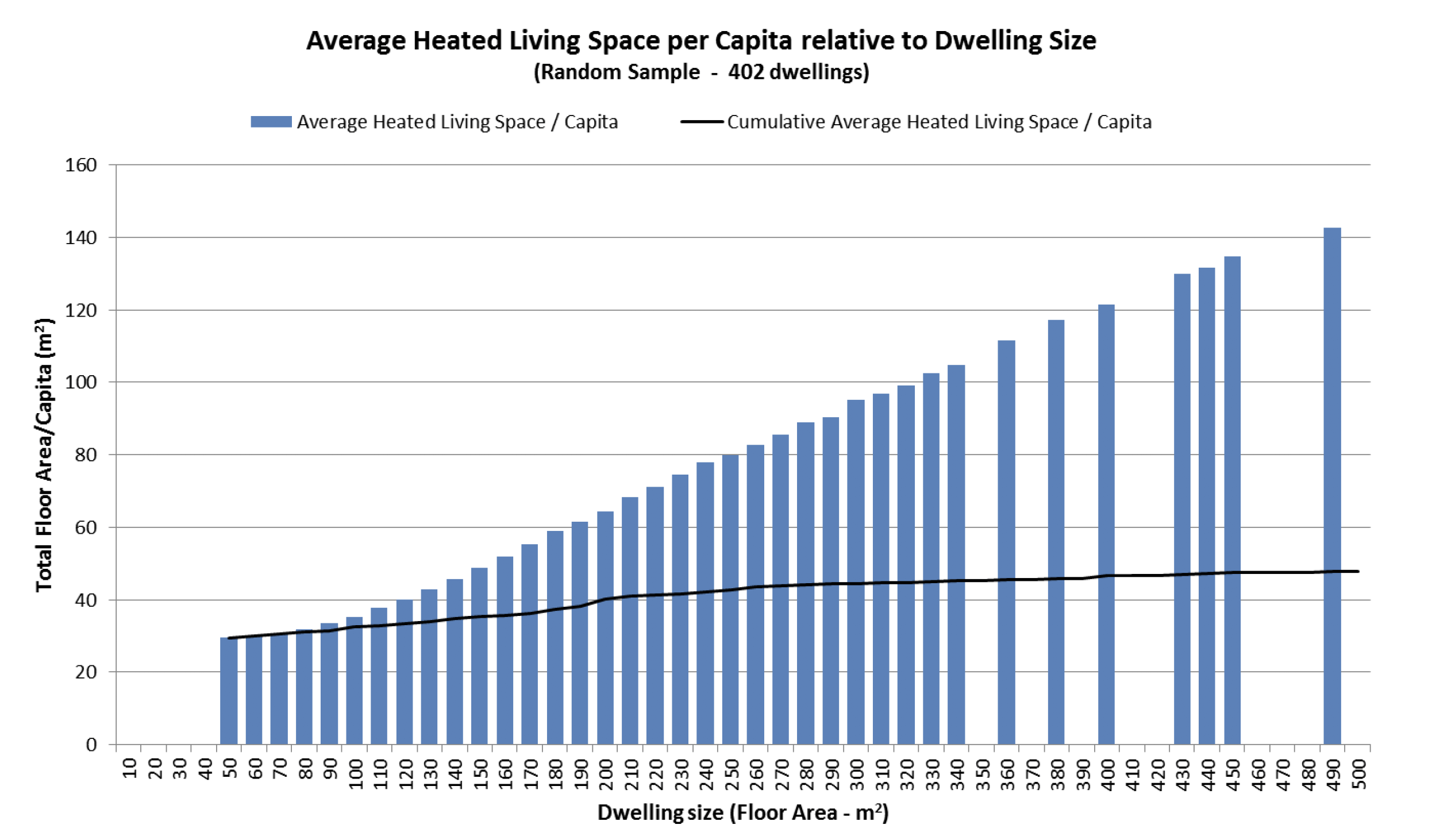
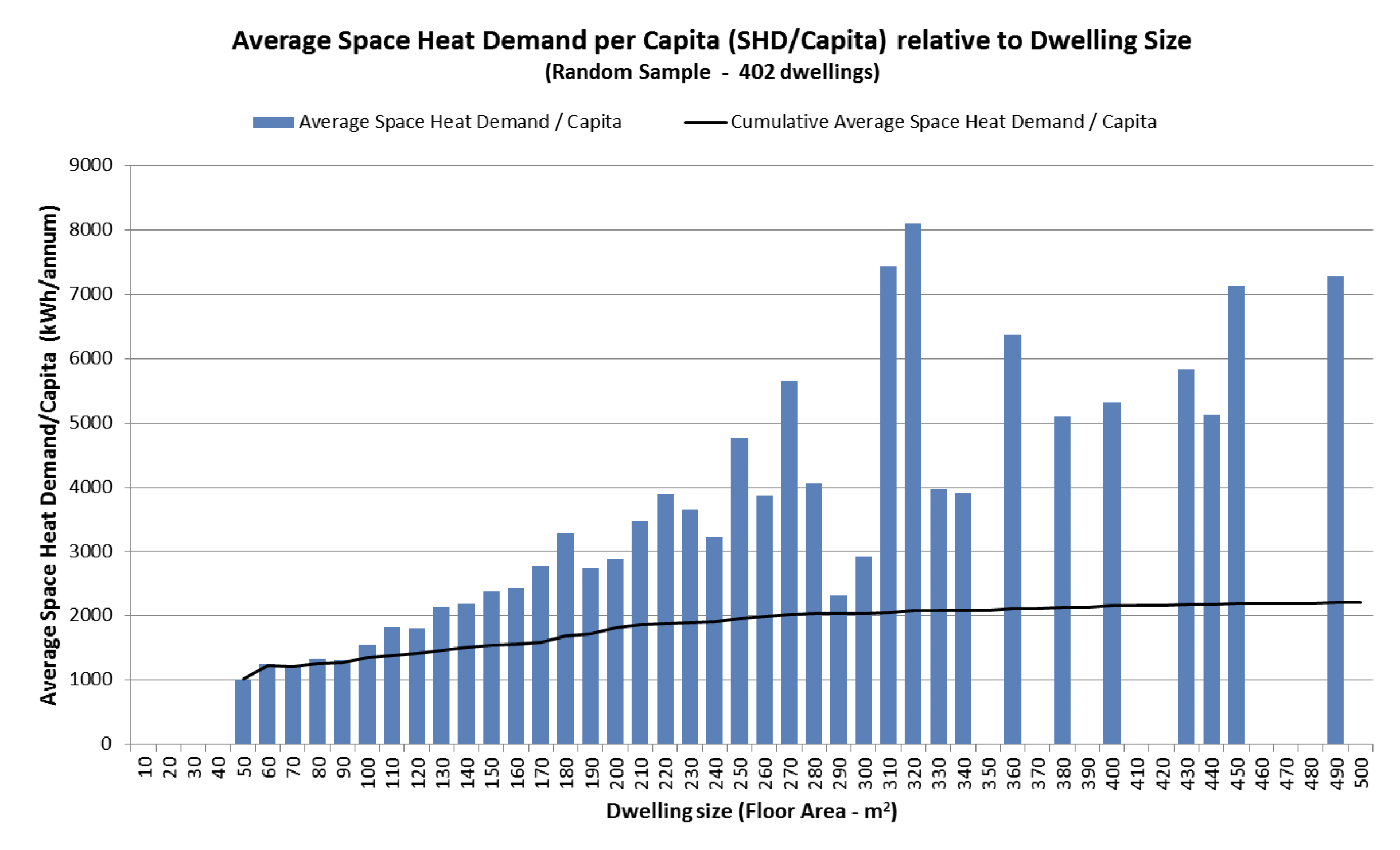
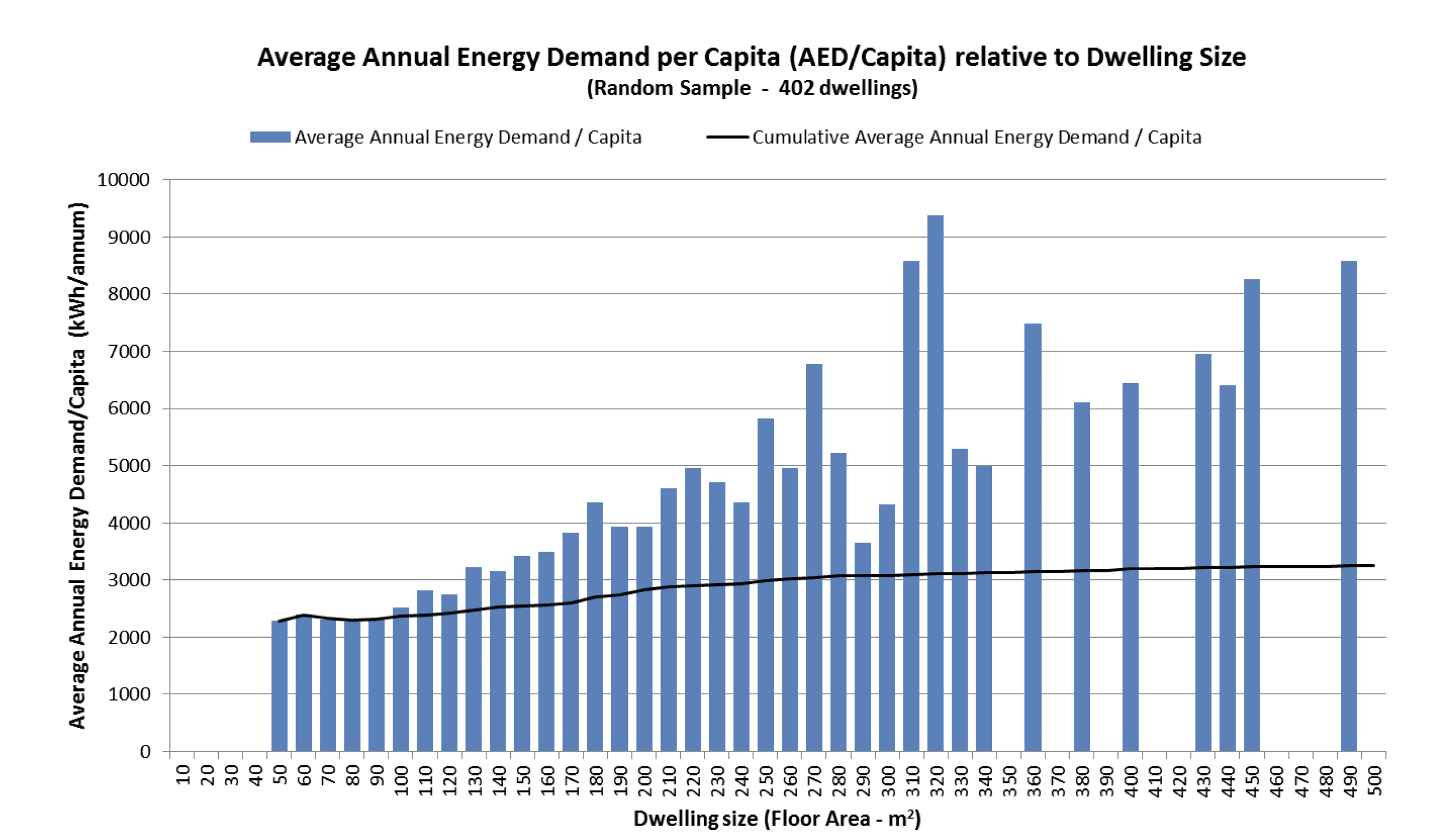
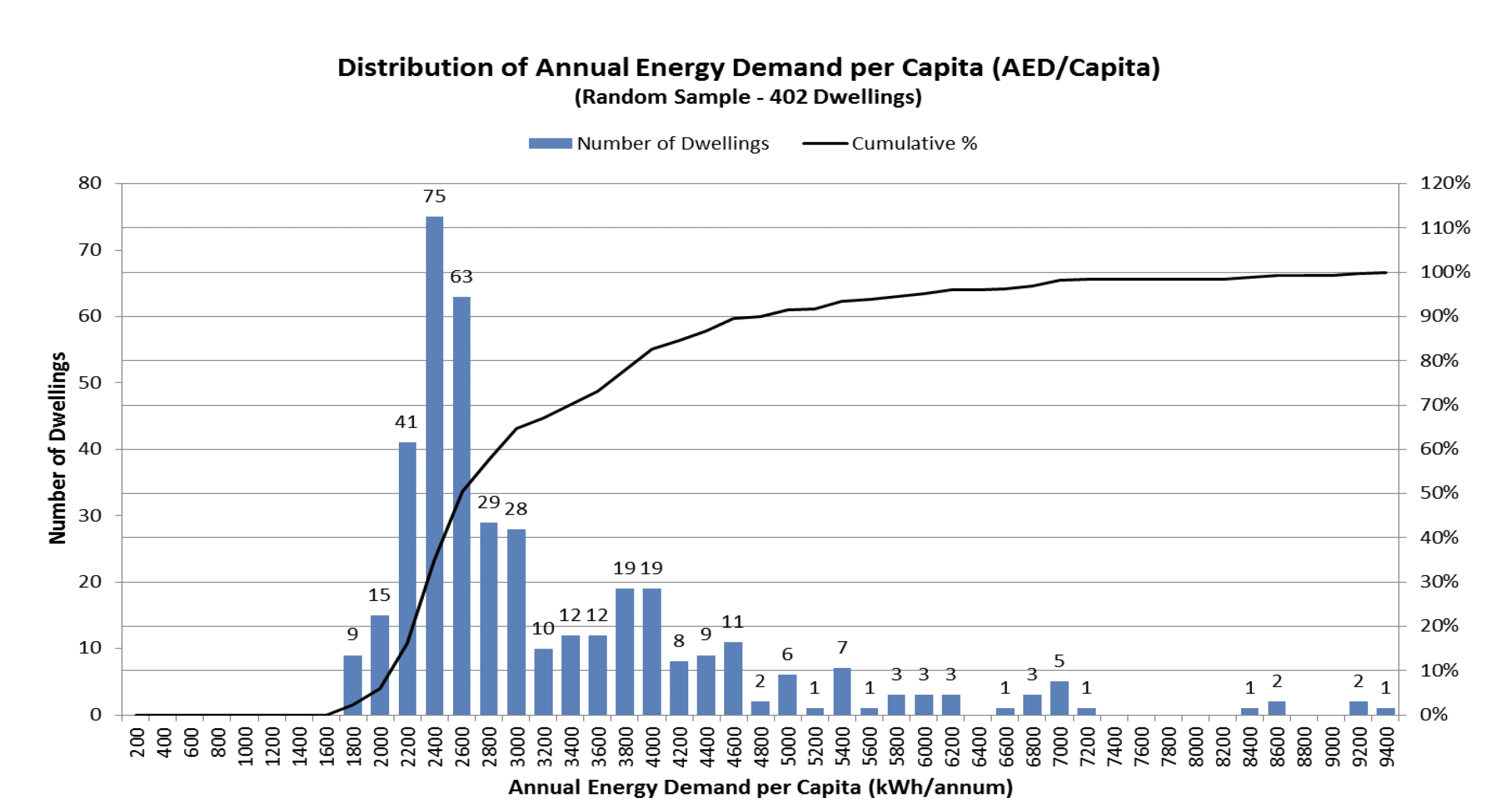
Contact
Email: chief.planner@gov.scot
There is a problem
Thanks for your feedback